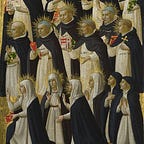St Catherine of Siena (part one)
Born Catherine Benincasa, Catherine of Siena is one of the medieval period’s most famous holy women, and with good reason. A contemplative and unique mystic, she developed a loyal band of disciples and influenced the end of the papal annexation of Florence, as well as the return of the papacy from Avignon to Rome. This was also all while being (largely and reportedly) an illiterate woman with no personal wealth. Catherine’s fame continued after her death, secured by the biography written by her confessor, Raymond of Capua. This biography emphasised her mysticism and visions and it is for this that she is largely still remembered today. However, it was this combined with her political efforts and her extraordinary literary output (she dictated 380 letters and thirty devotional works) that convince me she is worthy of admiration today. For such a short life (she was only thirty-three when she died) there is much to unpack, so for the sake of clarity, and because the chronology of her life is hazy, this post is divided in two parts, this one focusing on her mysticism and the second, to follow soon, focusing on her politics. I will also leave an extended reading list at the end of the second post.
Mysticism (or fasting and Christ’s foreskin)
Catherine’s religious life started at an extraordinary young age even for the time; she took a vow of virginity at seven years old and from that moment fixed her sights on joining the Dominican tertiary Order of the Sisters of Penance. These were nuns of the Dominican Order who lived in the community rather than in enclosed cloisters. This side of Catherine’s life is occasionally mentioned in her letters, but most of the information comes from her hagiography (saintly biography) written by Raymond of Capua. Raymond wrote this in an attempt to secure Catherine’s canonisation, so many of these mystical aspects of Catherine’s life (particularly the stories of her levitating) may be taken with a big pinch of salt. However, her ascetic lifestyle shown by Raymond appears to have been close to the truth of how she lived. For example, she would fast in an extreme way, sustained by the smallest amount of water, and live in a state where she would be more ill if she ate than when she abstained. This asceticism was intimately linked with her charity; she was known to give whatever she could away to the poor, despite having no personal property of her own. Raymond also reported that she would spend hours, or even days, in ecstatic visions, almost verging on death. It was these ecstatic visions that would form the basis of Catherine’s sanctity.
The most famous of these were her personal visions, confirming her personal and intimate relationship with Christ. Catherine was one of a special group of saints to receive the stigmata, the five wounds Christ suffered at the Crucifixion. She reported that she felt these wounds deeply, but they could not be seen by anyone but herself. Another of these invisible but intense mystical experiences was Catherine exchanging hearts with Christ. First, Christ appeared to Catherine, opened her chest and took out her heart from her body before closing up her chest. Catherine said she lived in this way, without a heart in her body, for several days. In the second vision, Christ once again open Catherine’s side, but this time placed his own heart inside her body. From this point on Catherine firmly believed she possessed Christ’s heart in her body, and supposedly the scar from where Christ opened her side was visible to her closest companions.
But, extraordinary as it may be, this was not the most famous of all Catherine’s mystical experiences. That accolade goes to her mystical marriage to Christ, an episode featured time and time again in artistic depictions of the saint. Becoming a bride of Christ (a sponsa Christi) was a rare marker of sanctity, that ironically confirmed the virginity of a female saint. Having a physical wedding ceremony to Christ, however, was even rarer. Here Catherine was clearing emulating her namesake, Katherine of Alexandria (who I’ll write about in future) who’s mystical marriage to Christ was a defining part of her sanctity. In Raymond of Capua’s account, the Virgin Mary, John the Evangelist, Paul the Apostle, St Dominic and the biblical David attend the marriage. Both Christ and Catherine say vows, and the marriage is confirmed when Christ places a gold and jewelled ring on her finger. So far, other than the fact the groom is Christ, things seem pretty traditional. What’s interesting is that, in Catherine’s letters, she describes how she was wedded to Christ with a ring of his foreskin. Yes, you did read that right. The fact this doesn’t appear in Raymond’s account suggests this was probably as bizarre and uncomfortable for a medieval audience as it is for us. Historians have spilled much ink discussing the significance of this foreskin ring and what it may mean for Catherine’s understanding of Christ and herself. For my part, without getting too bogged down in the arguments, I think it totally makes sense for a woman who’s visions of Christ focused hugely on his (and her) bodies and flesh to be married to him with a ring of that flesh. It signifies and reinforces the closeness of their relationship.
With such visions to discus, analyse and be entertained by, it is easy to forget Catherine’s public life and her importance as a political force in Italy. More on which next time!
